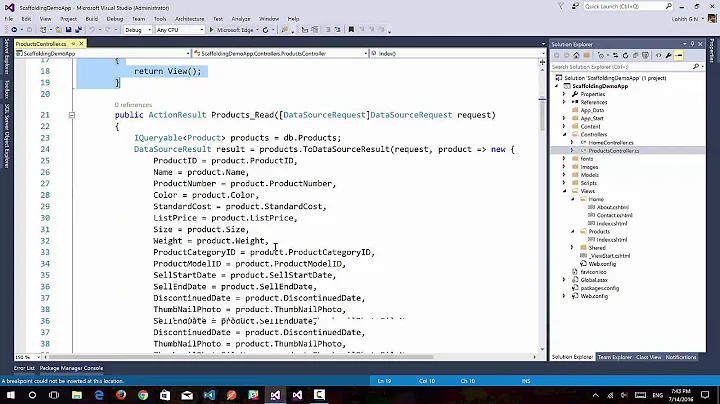Telerik grid ClientTemplate
Solution 1
First you might want to make sure SetupDate works by itself. If it does, you can try adding parentheses.
columns.Bound(p => p.SetupDate).ClientTemplate("<#= ((SetupDate == DateTime.Min) || (SetupDate == null)) ? string.Empty : SetupDate #>")
Or you can try using an if statement.
columns.Bound(p => p.SetupDate).ClientTemplate("<# if ((SetupDate != DateTime.Min) && (SetupDate != null)) { #><#= SetupDate #><# } #>")
Update The answer by NullReference is right where it says that you cannot use c# in the ClientTemplate. So you cannot use DateTime.Min or string.Empty.
One way to achieve the same thing is to use a javascript function. Define the column like this:
columns.Bound(p => p.SetupDate).ClientTemplate("<#= checkDate(SetupDate) #>")
Then add the javascript function, checkDate(). (There may be a better way to find min value, but getMilliseconds should be 0 if it is a min value.)
<script>
function checkDate(setupDate) {
if ((setupDate.getMilliseconds() === 0) || (setupDate === null))
return '';
else
return setupDate;
}
</script>
Solution 2
Client side templates are executed on the client in javascript, so you can't use C#. Anything surrounded by the "<# #>" correspond to properties on your model. I've found the best place to find this stuff out is to look at Telerik's demo pages here.
Related videos on Youtube
birdus
Updated on June 04, 2022Comments
-
birdus almost 2 years
I'm trying to use C# to apply a bit of logic when displaying a DateTime in a telerik grid in my MVC application, but am having some trouble getting it working. My first problem is that I don't understand exactly how the ClientTemplate call works. I wasn't able to find documentation explaining how it works, either. So, an explanation of how that works would be helpful, and then maybe specifically what's wrong with my example:
columns.Bound(p => p.SetupDate).ClientTemplate("<#= SetupDate == DateTime.Min || SetupDate == null ? string.empty : SetupDate #>")UPDATE:
I went with Daniel's suggestion. I just call this function from ClientTemplate(). Here is the final code:
// Setup a minDate to mimic C#'s Date.MinDate constant. var minDate = new Date(); minDate.setFullYear(1, 0, 1); minDate.setHours(0, 0, 0, 0); function checkDateWithFormat(d, f) { if (d.getTime() == minDate.getTime()) { return ""; } else { return d.toString(f); } } -
 Joshua over 11 yearsstring.empty should be string.Empty (I can't edit because its only a 1 char edit)
Joshua over 11 yearsstring.empty should be string.Empty (I can't edit because its only a 1 char edit) -
birdus over 11 yearsDoesn't that mean that anything surrounded by "<# #>" is executed on the server? Otherwise, it doesn't know about my model, right?
-
birdus over 11 yearsI thought about doing it this way, too, but if you return a string (instead of DateTime), the grid won't sort on that column properly.
-
 NullReference over 11 years@birdus "<# #>" doesn't mean it's executed on the server. That was the way with asp.net but this is purely client side binding.
NullReference over 11 years@birdus "<# #>" doesn't mean it's executed on the server. That was the way with asp.net but this is purely client side binding. -
Rustam over 11 yearsI think you mistaken about sorting issue. ClientTemplate is used to display data only. On column definition you bind it to some property (here it is .BindTo(m => m.SetupDate) ), and this property is used to sort a table. More over, the sorting happens on server side (an Ajax request is issued, and the table gets refreshed with new data).
-
birdus over 11 yearsAlthough I didn't use your exact code, I did use your idea. I'll post the final code above in the question. Thanks!
-
Daniel over 11 years@birdus That looks like a good way to do it. I like how you put the format for the date in the function.





